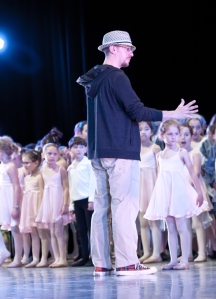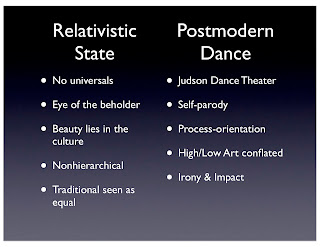Dance Paradigms (Part 4: Popular Dance)
From the group cohesive value systems in Traditional tribal, folk, and social dance, individuals  emerge with a desire to express themselves, displaying their prowess, in contrast to others--meeting the needs and motivations of the Gravesian Egoistic system.
emerge with a desire to express themselves, displaying their prowess, in contrast to others--meeting the needs and motivations of the Gravesian Egoistic system.
Here, the individual discovers what Graves calls the “awareness of self as a possibly powerful being separate and distinct from others.” This is found in courting dances, recreational dance studios, Ethnic dance, and entertainment or commercial dance.
Courting dances, from those found in the rituals of traditional cultures to the pea-cocking behavior of contemporary college students dancing at the local bar, exhibit traditional Egoistic motivations.
On a more personal level, I started dance classes at thirteen and enjoyed the camaraderie of my classmates more than anything else. I felt I belonged within the group. Over time, I began to gain confidence in my ability and wanted to explore how I could express my individual prowess in relation to the rest of the group.
Recreational dance studios engaging a studio-based model of dance education (in contrast to an educational-based model) often operate primarily between the Traditional and Popular states--promoting a mix of both team identity (Traditional/Tribalistic: our studio is the best) and individual prowess in self-expression (Popular/Egoistic: my solo is the best).
But why isn’t Ethnic dance included in the Traditional dance category? Ethnic dance derives from the tribal and social dance forms but then develops as a way to delineate the individuality and prowess of one group from all others. Where tribal and social dance are meant for others within the group, ethnic dance developed as the group enters an Egoistic stage and expresses itself for outsiders, even as performed on concert stages in the role of cultural ambassador.
Entertainment and commercial dance often has as its primary purpose the intention to influence, persuade, or seduce. (One can get a whiff of the perennial art versus entertainment debate brewing here.) Jazz dance, tap dance, and present social dance forms (such as Hip Hop) openly display these values--especially in movies and television. That is not to say that individuals in entertainment and commercial dance do not operate in other states, but rather, that the prime values for the majority of the work comes from the Graves Egoistic state.
When the traditional and popular forms of dance are codified into a strict canon, the classical dance forms emerge...
 emerge with a desire to express themselves, displaying their prowess, in contrast to others--meeting the needs and motivations of the Gravesian Egoistic system.
emerge with a desire to express themselves, displaying their prowess, in contrast to others--meeting the needs and motivations of the Gravesian Egoistic system. Here, the individual discovers what Graves calls the “awareness of self as a possibly powerful being separate and distinct from others.” This is found in courting dances, recreational dance studios, Ethnic dance, and entertainment or commercial dance.
Courting dances, from those found in the rituals of traditional cultures to the pea-cocking behavior of contemporary college students dancing at the local bar, exhibit traditional Egoistic motivations.
On a more personal level, I started dance classes at thirteen and enjoyed the camaraderie of my classmates more than anything else. I felt I belonged within the group. Over time, I began to gain confidence in my ability and wanted to explore how I could express my individual prowess in relation to the rest of the group.
Recreational dance studios engaging a studio-based model of dance education (in contrast to an educational-based model) often operate primarily between the Traditional and Popular states--promoting a mix of both team identity (Traditional/Tribalistic: our studio is the best) and individual prowess in self-expression (Popular/Egoistic: my solo is the best).
But why isn’t Ethnic dance included in the Traditional dance category? Ethnic dance derives from the tribal and social dance forms but then develops as a way to delineate the individuality and prowess of one group from all others. Where tribal and social dance are meant for others within the group, ethnic dance developed as the group enters an Egoistic stage and expresses itself for outsiders, even as performed on concert stages in the role of cultural ambassador.
Entertainment and commercial dance often has as its primary purpose the intention to influence, persuade, or seduce. (One can get a whiff of the perennial art versus entertainment debate brewing here.) Jazz dance, tap dance, and present social dance forms (such as Hip Hop) openly display these values--especially in movies and television. That is not to say that individuals in entertainment and commercial dance do not operate in other states, but rather, that the prime values for the majority of the work comes from the Graves Egoistic state.
When the traditional and popular forms of dance are codified into a strict canon, the classical dance forms emerge...


Agen Slot
ReplyDeletePanduan Judi Onlie
Movie TIme